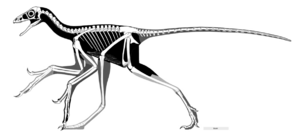Fujianvenator facts for kids
Quick facts for kids Fujianvenator |
|
|---|---|
| Scientific classification | |
| Genus: |
Fujianvenator
|
| Species: |
prodigiosus
|
Fujianvenator (which means "Fujian hunter") is an extinct animal that was a very early bird relative. It lived during the Late Jurassic period in what is now Fujian Province, China. This amazing creature is known from a fossil of a partial skeleton. Scientists think Fujianvenator might have lived on land or waded in shallow water.
Contents
Finding Fujianvenator
The first fossil of Fujianvenator was found in October and November of 2022. It was discovered during special trips to the Nanyuan Formation, near a village called Yangyuan in Zhenghe County, China.
The fossil is a partial skeleton, meaning not all of its bones were found. It's missing the skull (head), neck, and the very end of its tail. The bones were found pressed flat in two pieces of rock, like a sandwich.
In 2023, a group of scientists led by Xu et al. studied these fossils. They named it Fujianvenator prodigiosus. The name "Fujianvenator" combines "Fujian" (where it was found) with the Latin word "venator," meaning "hunter." The second part of its name, "prodigiosus", comes from a Latin word that means "bizarre" or "unusual," because of its strange body features.
What Fujianvenator Looked Like
Fujianvenator was a small animal, weighing about 641 grams (around 1.4 pounds). This is similar in size to a koklass pheasant, a type of bird.
When scientists looked at the fossil, they noticed that some of its bones were not fully grown together. This tells us that the Fujianvenator that was found was not yet a fully grown adult when it died. However, other bones showed that it was likely a subadult, meaning it was almost fully grown.
How Fujianvenator Lived
Fujianvenator had some unique body parts. For example, its shoulder blade was shorter compared to its arm bone than in other similar animals. In birds that can fly well, the shoulder blade is usually longer because it helps with strong flight muscles.
Also, the bones in its hand (called metacarpals) suggest that Fujianvenator had flexible fingers that could grasp things. This might have helped it catch food. In more advanced bird relatives, these hand bones are usually fused together and mostly help to hold flight feathers.
One of the most interesting things about Fujianvenator was its very long legs. Its lower leg bone (tibia) was twice as long as its thigh bone (femur)! This suggests it might have spent more time on the ground than in trees or flying. Animals with long lower legs and feet are often good at running, because these long bones help them take bigger steps.
Scientists studied how well different dinosaurs could run. Fujianvenator scored very high, even better than dinosaurs like troodontids and tyrannosaurids, which were known for being fast runners. This means Fujianvenator was likely a very fast runner.
However, long legs are also seen in birds that wade in water, like cranes and storks. The leg proportions of Fujianvenator are similar to these wading birds. So, it's also possible that it spent its time wading in shallow water. Since its toe bones are not well preserved, it's hard to know for sure if it was a runner, a wader, or both!
Fujianvenator's Family Tree
Scientists believe that Fujianvenator belongs to a group called Anchiornithidae. They think this group represents some of the earliest bird relatives. Other studies have placed Anchiornithidae in different spots on the dinosaur family tree, sometimes closer to Troodontidae or Archaeopteryx.
Here is a simplified family tree showing where Fujianvenator fits in:
| Pennaraptora |
|
|||||||||||||||||||||||||||||||||||||||||||||||||||||||||||||||||||||
Where Fujianvenator Lived
Fujianvenator lived about 149.9 to 150.2 million years ago, during the Late Jurassic period. Its fossil was found in rock layers of the Nanyuan Formation.
Most of the other animal fossils found in this area were from water-dwelling or semi-aquatic animals. These included different kinds of fish, turtles, and other ancient reptiles called choristoderes. Scientists call this collection of fossils the Zhenghe Fauna.
Finding Fujianvenator alongside these water animals suggests that it lived in a swampy environment. This is quite unusual for an early bird relative! This idea, along with its long legs, supports the theory that Fujianvenator might have lived like modern wading birds, walking through shallow water.


